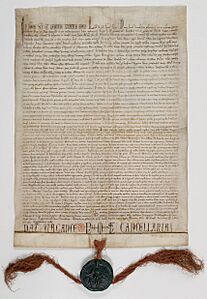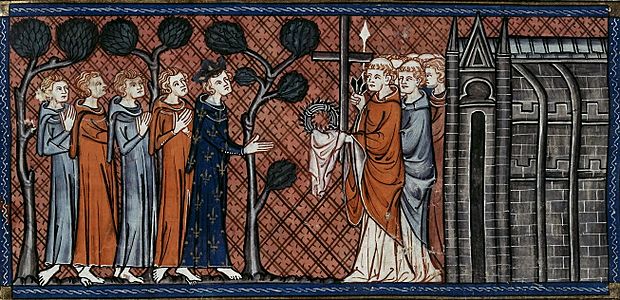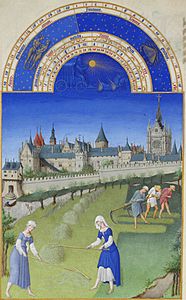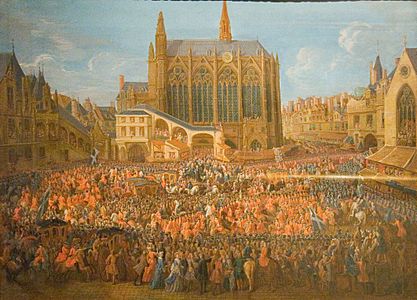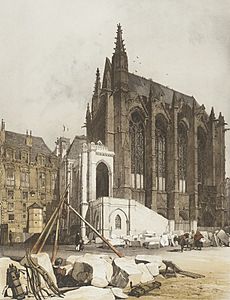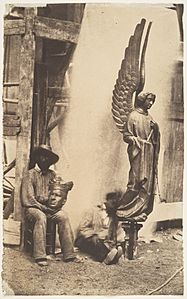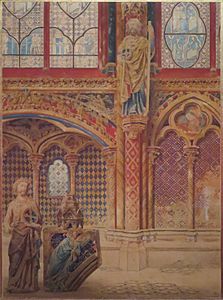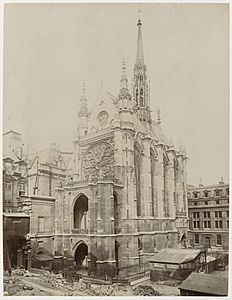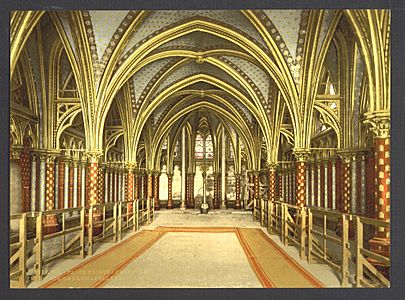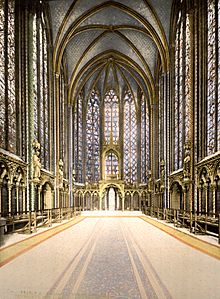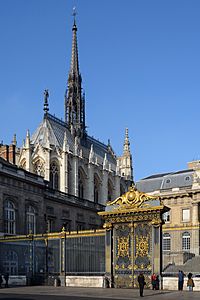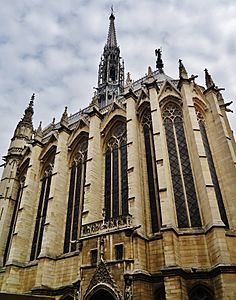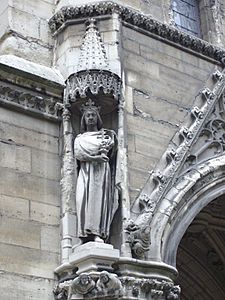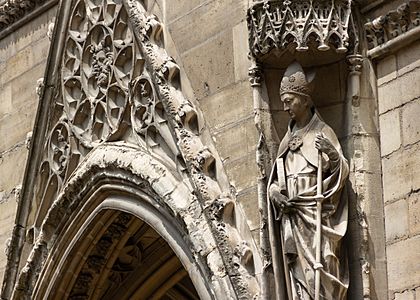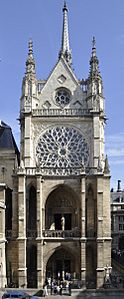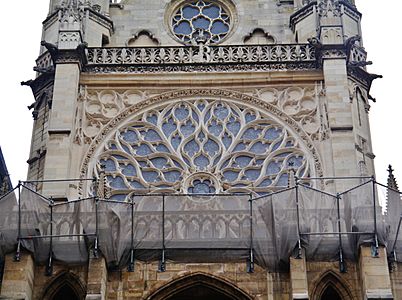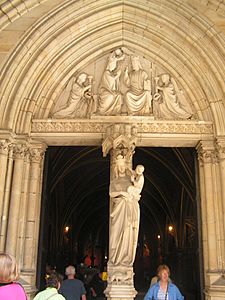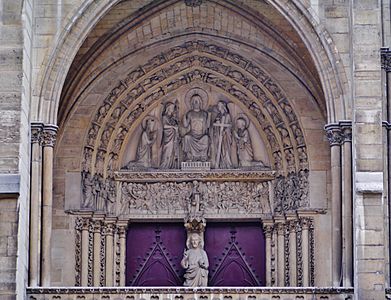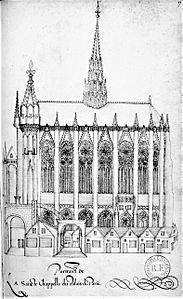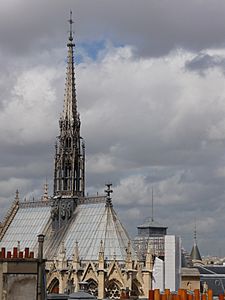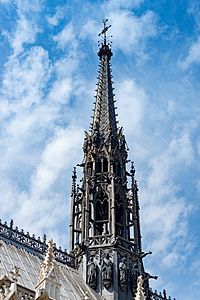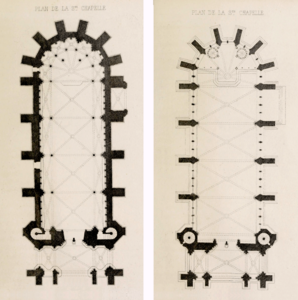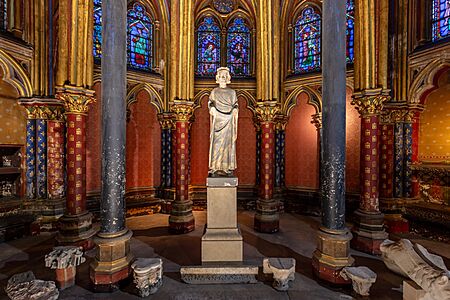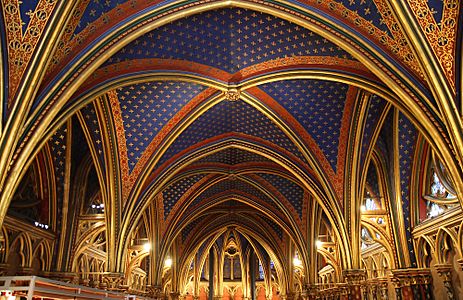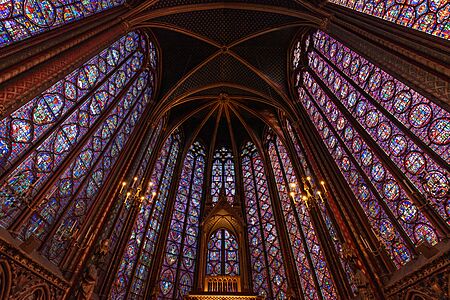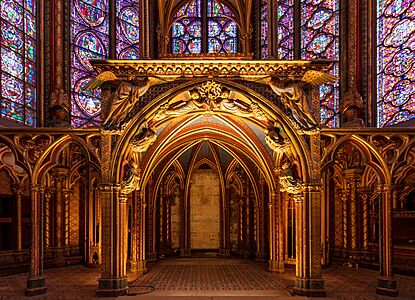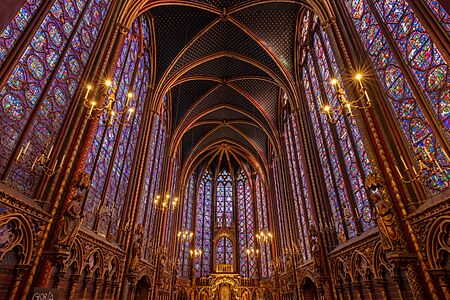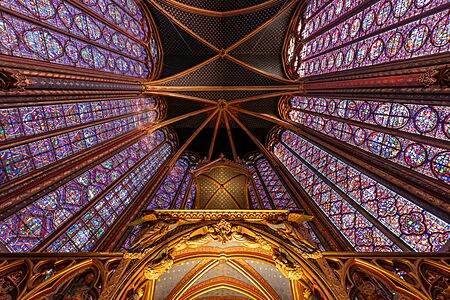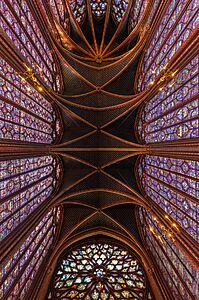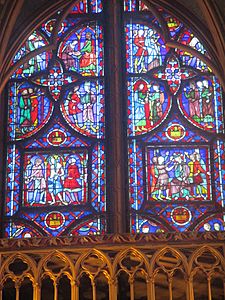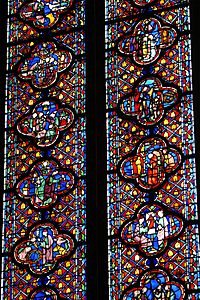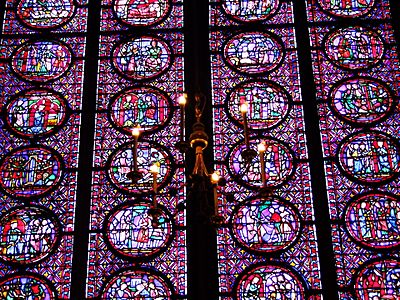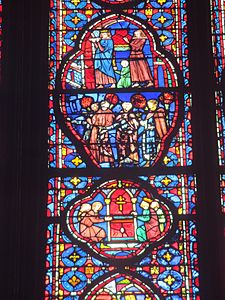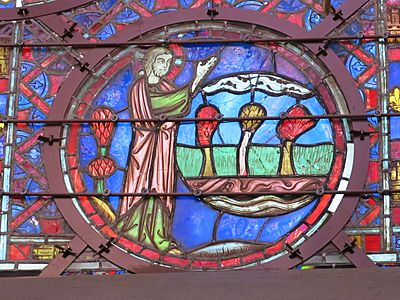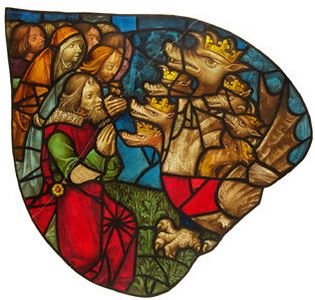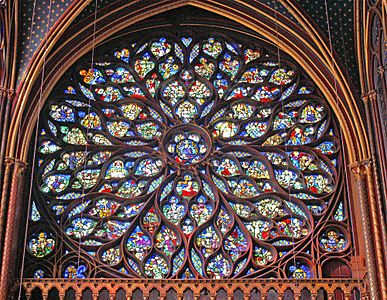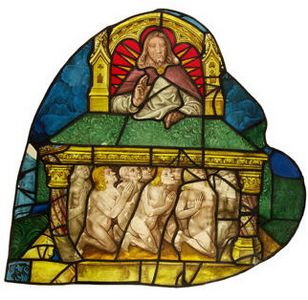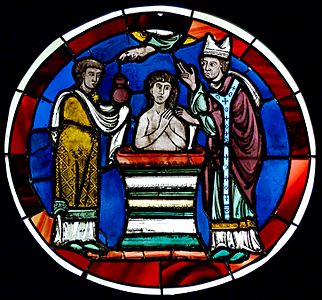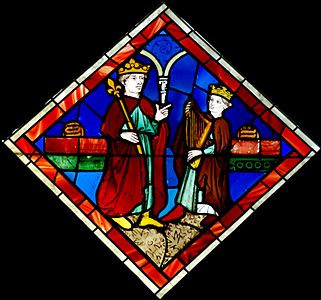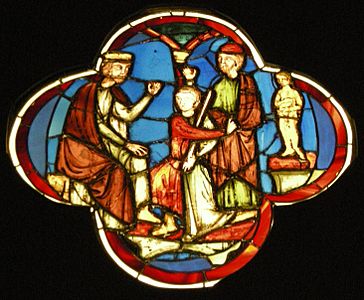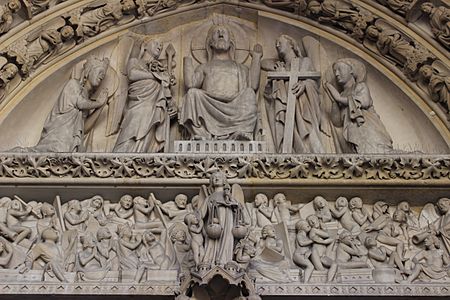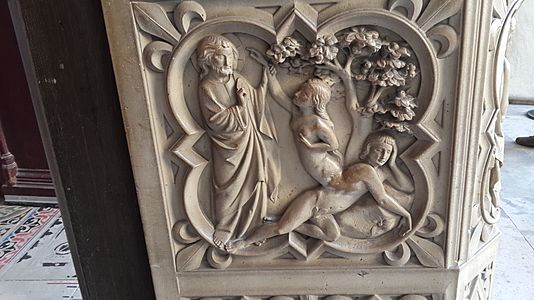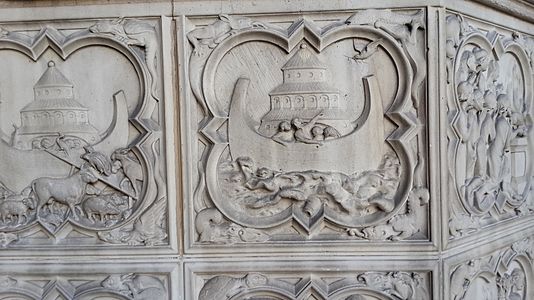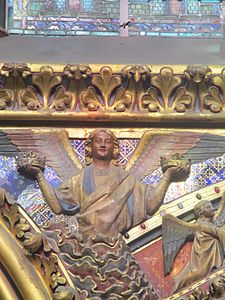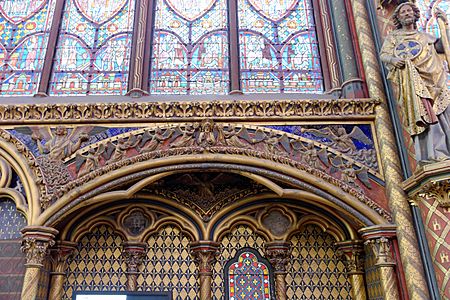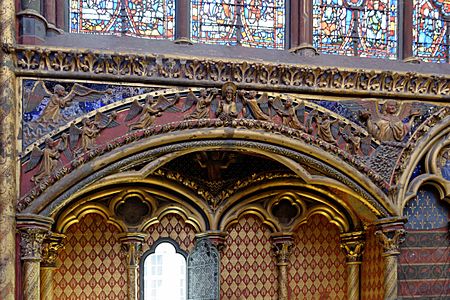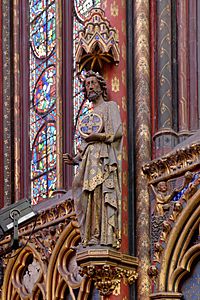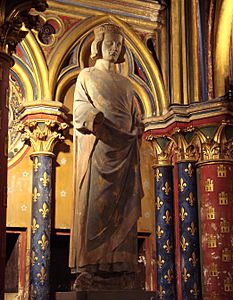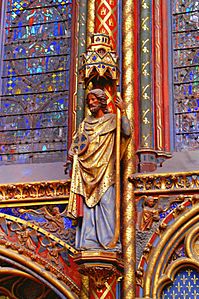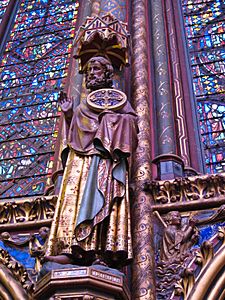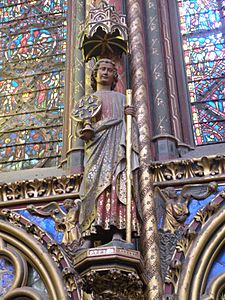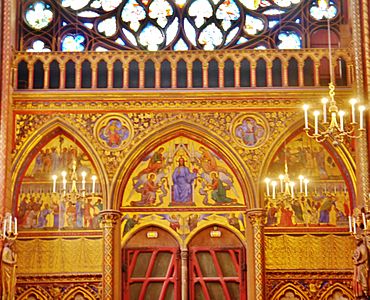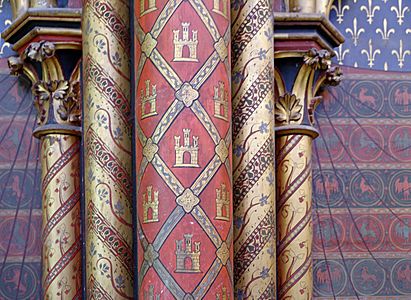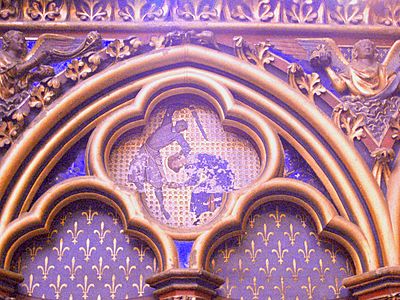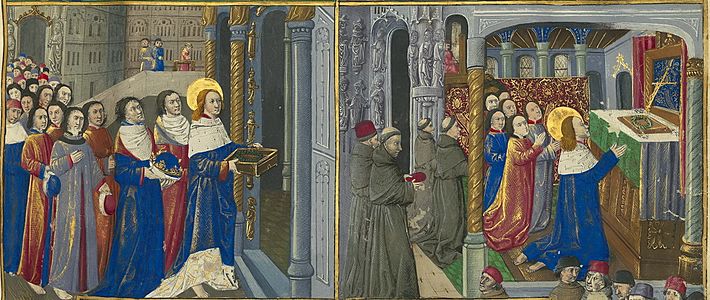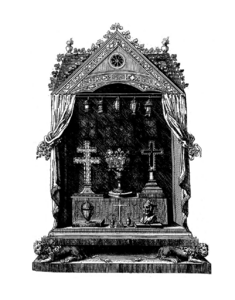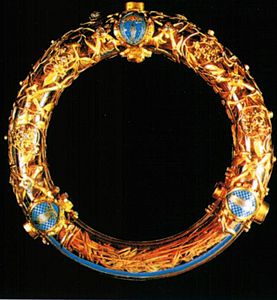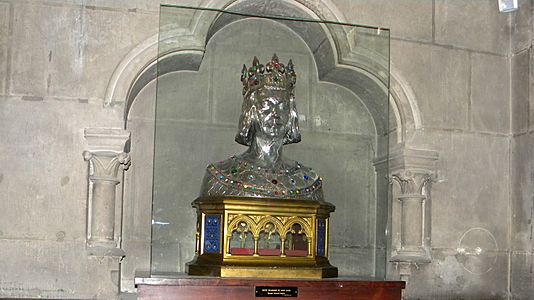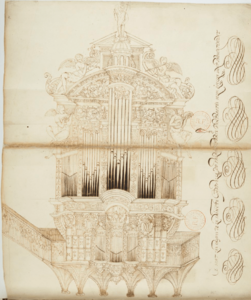Sainte-Chapelle facts for kids
Quick facts for kids Sainte-Chapelle |
|
|---|---|
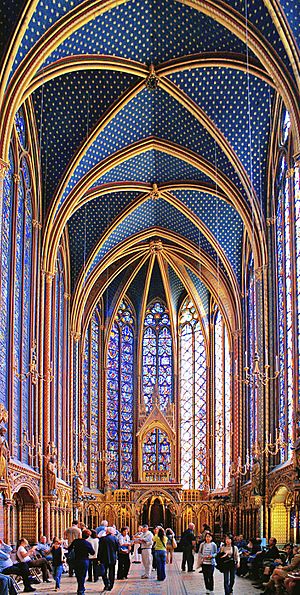
Sainte-Chapelle, upper level interior
|
|
| Religion | |
| Affiliation | Catholic Church |
| Province | Archdiocese of Paris |
| Region | Île-de-France |
| Rite | Roman Rite |
| Status | Secularized since French Revolution |
| Location | |
| Location | 10, boulevard du Palais, 1st arrondissement |
| Municipality | Paris |
| Country | France |
| Architecture | |
| Architectural type | Royal chapel |
| Architectural style | Rayonnant Gothic |
| Groundbreaking | 1242 |
| Completed | 1248 |
|
Monument historique
|
|
| Official name: Sainte-Chapelle | |
| 1862 | |
| PA00086001 | |
| Denomination | Église |
The Sainte-Chapelle (which means Holy Chapel in English) is a beautiful royal chapel in the Gothic style. It is located inside the old Palais de la Cité in Paris, France. This palace was once where the Kings of France lived until the 1300s. You can find it on the Île de la Cité, an island in the Seine River.
Construction of the chapel started after 1238 and it was officially opened on April 26, 1248. Sainte-Chapelle is known as one of the best examples of the Rayonnant period of Gothic architecture. King Louis IX of France ordered it to be built. He wanted a special place to keep his collection of important Passion relics. These included what was believed to be Christ's Crown of Thorns. This crown was one of the most important relics in Europe during the Middle Ages. It was later kept at Notre-Dame Cathedral until the 2019 fire, which it survived.
Sainte-Chapelle and the Conciergerie are two of the oldest buildings left from the Capetian royal palace on the Île de la Cité. Even though it was damaged during the French Revolution and fixed up in the 1800s, it still has one of the largest collections of 13th-century stained glass in the world.
Today, the chapel is a museum run by the Centre des monuments nationaux. It is managed along with the nearby Conciergerie, which is another part of the original palace.
Contents
History of the Holy Chapel
Building the Royal Chapel
Sainte-Chapelle was inspired by older royal chapels, especially the Palatine Chapel built by Charlemagne around 800 AD. King Louis IX had already built a royal chapel at the Château de Saint-Germain-en-Laye in 1238. This earlier chapel had only one floor. Its design, but much bigger, was used for Sainte-Chapelle.
The new chapel had two levels, both the same size, but used for different things. The upper level held the sacred relics and was only for the royal family and their guests. The lower level was for the palace's courtiers, servants, and soldiers. It was a very large building: 36 meters (118 ft) long, 17 meters (56 ft) wide, and 42.5 meters (139 ft) high. Its size was similar to the grand Gothic cathedrals being built in France at the time.
Sainte-Chapelle was not just a place of worship. It also showed King Louis's power and influence. At that time, the Holy Roman Empire was in disarray. Louis wanted to show that he was the most important king in western Europe. The chapel helped him do this. He could walk directly from his palace into Sainte-Chapelle, just like the Emperor in Constantinople could walk into the Hagia Sophia. Having a piece of the True Cross and the Crown of Thorns gave Louis IX great respect. Pope Innocent IV even said it meant Christ had symbolically crowned Louis with his own crown.
The King's Special Chapel
-
Charter of foundation of the Sainte-Chapelle by Louis IX (1246)
-
Illustration in Très Riches Heures du Duc de Berry (c. 15th century)
Sainte-Chapelle was built in the royal palace courtyard to hold Louis IX's collection of Christ's relics. These included the crown of thorns, the Image of Edessa, and about thirty other items. Louis bought these Passion relics from Baldwin II, the Latin emperor in Constantinople. He paid 135,000 livres for them. This money went to the Venetians, who had been holding the relics as a loan.
The relics arrived in Paris in August 1239. They were carried from Venice by two Dominican friars. When they arrived, King Louis held a week-long celebration. For the last part of their journey, Louis IX himself carried them, walking barefoot and dressed simply. This scene is shown in the Relics of the Passion window on the chapel's south side. The relics were kept in a large, fancy silver chest called the Grand-Chasse. Louis spent another 100,000 livres on this chest.
In comparison, the entire chapel itself cost 40,000 livres to build and put in the glass. Before it was finished in 1248, the relics were kept in chapels at the Château de Vincennes and a special chapel at the Château de Saint-Germain-en-Laye. In 1246, pieces of the True Cross and the Holy Lance were added to Louis's collection. The chapel was officially opened on April 26, 1248. Louis's relics were moved to their new home with a big ceremony. Soon after, the King left for the Seventh Crusade, where he was captured but later freed after a ransom was paid.
Changes Over Time (1500s–1700s)
The chapel was changed quite a bit over the centuries. A new two-story building, the Treasury of Chartres, was added to the north side shortly after the chapel was finished. It stayed there until 1783, when it was torn down to build the new Palace of Justice. Another building, used as a changing room and storage, was also on the north side. In the 1400s, Louis X of France built a large enclosed staircase from the courtyard to the upper level. This staircase was damaged by fire in 1630, rebuilt, but later removed. Fires in the palace in 1630 and 1776 also caused a lot of damage, especially to the furniture. A flood in the winter of 1689–1690 badly damaged the painted walls of the lower chapel. The original stained glass on the ground floor was removed, and the floor was raised. New Gothic-style windows replaced the original ground floor glass in the 1800s.
Damage During the French Revolution
Sainte-Chapelle was a target during the French Revolution because it represented both religion and royalty. The chapel was turned into a storage place for grain. The sculptures and royal symbols on the outside were destroyed. The spire was pulled down. Some of the stained glass was broken or scattered, but almost two-thirds of the glass today is original. Some original glass was moved to other windows. The sacred relics were spread out, though some still exist as the "relics of Sainte-Chapelle" in the treasury of Notre-Dame de Paris. Many reliquaries, including the grande châsse, were melted down for their valuable metal.
Restoring the Chapel (1800s–Today)
Between 1803 and 1837, the upper chapel was used to store records for the Palace of Justice next door. The bottom two meters (6 ft 7 in) of stained glass was removed to let in more light for working. Some of this glass was used to fix other broken windows, and some pieces were sold.
Starting in 1835, experts and writers asked for the church to be saved and restored to how it looked in the Middle Ages. In 1840, under King Louis-Philippe, a long restoration project began. It was first led by Félix Duban, then by Jean-Baptiste Lassus and Émile Boeswillwald. The young Eugène Viollet-le-Duc helped them. The work lasted for twenty-eight years. It helped train many future experts in history and restoration. The team made sure to follow the original drawings and descriptions of the chapel that still existed.
Restoring the stained glass was another big project, from 1846 to 1855. The goal was to make the chapel look like it did originally. Glass artists Antoine Lusson and Maréchal de Metz, along with designer Louis Steinheil, did this work. About one-third of the glass, which had been added later, was removed. It was replaced with medieval glass from other places or new glass made in the original Gothic style. Eighteen of the original panels are now in the Musée de Cluny in Paris.
The stained glass was removed and stored safely during World War II. In 1945, a layer of special coating was put on the outside to protect the glass from dust and scratches from wartime bombing. This coating slowly got darker, making the already faded images even harder to see. In 2008, a bigger, seven-year restoration project began. It cost about €10 million to clean and save all the stained glass, clean the stone on the outside, and fix some of the sculptures. Half of the money came from private donations, and the other half from the Villum Foundation. As part of the restoration, a new layer of special glass was added outside the stained-glass windows for extra protection. The restoration of the beautiful rose window on the west side was finished in 2015. This was just in time for the 800th birthday of St. Louis.
Timeline of Sainte-Chapelle
- 1239 - Louis IX buys the famous Crown of Thorns.
- 1241 - The crown and other relics arrive in Paris.
- 1242-44 - Construction of the chapel begins.
- 1248 - Sainte-Chapelle is finished and officially opened.
- 1264-1267 - The special platform for the relics is installed.
- 1379 - Charles V of France gives the Sainte-Chapelle Gospels to the treasury.
- 1383 - The first spire is rebuilt.
- Late 1400s - A large outdoor staircase is built by Louis XII.
- Around 1460 - The 14th-century spire is replaced.
- 1485-1498 - The west rose window is installed.
- 1630 - Fire damages the spire and outer staircase.
- 1690 - A flood damages the lower chapel; original lower chapel stained glass is removed.
- 1793 - Revolutionaries destroy portals and royal symbols. The chapel is used for other purposes, and the spire is destroyed.
- 1803-1837 - The chapel becomes a storage room for government files.
- 1805 - Relics of the Passion are moved to Notre-Dame de Paris.
- 1840-48 - Major restoration of the chapel and its decorations begins.
- 1846-55 - Restoration and additions to the stained glass windows.
- 1853-55 - The current spire is built.
- 1862 - The chapel is recognized as a historical monument.
Exploring the Chapel's Design
The royal chapel is a great example of the "Rayonnant" phase of Gothic architecture. This style is known for making buildings feel light and tall. The chapel sits on top of a lower chapel, which served as a church for everyone living in the palace.
Outside the Chapel
-
Louis IX holding a fragment of the true cross
When visitors entered the Royal Palace courtyard, they would have seen a grand staircase on their right. On their left, they would see the north side and eastern end of Sainte-Chapelle. The outside of the chapel shows many features of Rayonnant architecture. These include deep supports (buttresses) with pointed tops (pinnacles), pointed decorations (crocketted gables) around the roof, and huge windows divided by stone patterns (bar tracery). The chapel's two levels are clearly visible from the outside. The lower walls have smaller windows shaped like a spherical triangle. Despite its decorations, the outside is quite simple. It doesn't have flying buttresses or many large sculptures, so it doesn't hint at how rich the inside is.
No specific architect is named in the old records. In the 1800s, people thought it was built by Pierre de Montreuil, who worked on other famous buildings. But modern experts don't agree. They think it might have been Jean de Chelles or Thomas de Cormont.
West Side Entrance
The west side has a two-story porch. Above it is a beautiful flamboyant Gothic rose window, added in the 1400s. At the very top is a pointed arch, a round window, and a railing around the roof. This railing is decorated with fleur-de-lys symbols, put there by Charles V of France. On each side of the porch are towers with narrow spiral staircases leading to the upper chapel. These towers also hide the buttresses. The spires of the towers are also decorated with royal fleur-de-lys under a sculpted crown of thorns. These decorations are from the 1400s and were fixed around 1850.
The entrance to the upper chapel is on the balcony of the upper level. The original sculptures on the west entrance were destroyed during the Revolution. They were restored between 1854 and 1873.
The Chapel's Spire
The current spire is thirty-three meters (108 ft) tall. It is the fifth spire built on Sainte-Chapelle since the 1200s. We don't know what the first one looked like. The second one, built in 1383 under Charles V, is shown in an old drawing. It was replaced around 1460, but this spire burned down in 1630. Another one was built, but it was destroyed after the French Revolution in 1793. The spire you see today was built from cedar wood by architect Lassus starting in 1852. The sculptures on the spire were designed in 1853. The artist who designed the sculptures at the base of the spire even put his own face on two of the apostles, Saint Thomas and Saint Bartholomew. Above the pointed decorations are statues of angels holding items from The Passion. Above the eastern end is a statue of the Archangel Michael fighting a dragon. Around the archangel's feet are sculptures of eight people, who were workers on the reconstruction, placing wreaths.
Inside the Chapel
Sainte-Chapelle was built to hold a special container for relics. It was designed like a precious container itself, with the most beautiful decorations on the inside. While the stained glass is the main feature, every part of the walls and ceiling was also richly colored and decorated. Studies of old paint pieces show that the original colors were much brighter than what the 1800s restorers used. They would have been similar to the colors in the stained glass. The four-leaf clover shapes (quatrefoils) on the lower walls were painted with scenes of saints and martyrs. They had painted and gilded glass inside, like fancy enamel art. Rich fabric hangings also made the inside look even grander.
The most amazing and unique thing about the upper chapel is that it hardly has any stone walls. The walls are mostly replaced by tall pillars and supports. The space between these is almost entirely glass, filling the upper chapel with light.
The Lower Chapel
The lower chapel was dedicated to the Virgin Mary. It was used by the people who lived in the Royal Palace but were not part of the royal family. The entrance to the chapel has a statue of the Virgin Mary. This entrance, and almost all the decorations in the chapel, were made between 1854 and 1858. The main decorations on the sculptures, columns, and paintings are the Fleur-de-Lys symbol of Louis IX and a stylized castle. The castle is the symbol of Blanche of Castile, Louis IX's mother.
The lower chapel is only 6.6 meters (22 ft) high. It has a central area 6 meters (20 ft) wide and two narrow side aisles. The way the ceiling vaults are supported is unusual. Small, elegant arched supports between the outer and inner columns balance the outward push of the vaults. They are also strengthened by metal hidden under the paint and plaster.
The 140 column tops (capitals) are an important part of the decoration. They are from the mid-1200s and are older than the columns in the upper chapel. They have floral designs of acanthus leaves, which were common at that time. Each gilded leaf matches a thin column above it, which goes up to support the ceiling. The columns are painted with alternating floral designs and the castle symbol of Castile. The red, gold, and blue paint is from the 1800s restoration.
The original stained glass in the lower chapel was destroyed by a flood in 1690. It was replaced with clear glass. The current glass shows scenes from the life of the Virgin Mary, surrounded by gray (grisaille) glass. The eastern end has more detailed and colorful scenes from the Virgin's life. All these windows were designed in the 1800s. The lower chapel originally had a doorway to the sacristy (a room for church items) on the left side. Since it couldn't have a window, it was decorated in the 1200s with a painting of the Annunciation. This painting was found again during the 1800s work and restored.
The Upper Chapel
You reach the upper chapel by narrow staircases in the towers from the lower level. The design is simple: a rectangle 33 by 10.7 meters (108 by 35 ft), with four sections and a rounded end (apse) at the east with seven window sections. The most amazing part is that the walls seem to be almost entirely made of stained glass. There are a total of 670 square meters (7,200 sq ft) of glass, not counting the rose window at the west end. This was a clever trick by the builder. Each vertical support for the windows is made of seven thin columns, which hide how thick they really are. Also, the walls and windows are held up on the outside by two bands of iron chain. These are hidden behind the bars holding the stained glass. More metal supports are hidden under the roof to help the windows stand strong against wind. The windows in the main part of the chapel are also slightly taller than those in the apse (15.5 meters, 51 ft compared to 13.7 meters, 45 ft). This makes the chapel look longer than it actually is.
There are two small private areas built into the walls in the third section of the chapel. Their arches are richly decorated with paintings and sculptures of angels. These were the places where the King and Queen prayed during church services. The King was on the north side, and the Queen on the south.
Vaults of the Upper Chapel
-
Vaults of the apse (Note the fleur-de-lis symbol, inherited from the Capet line of Louis IX's father, Louis VIII Capet, of France)
Amazing Stained Glass Windows
The most famous parts of the chapel are its fifteen large stained-glass windows. They are among the best in the world. These windows are in the main part of the chapel and the apse, and they are from the mid-1200s. The rose window at the west end was added later, in the 1400s. The stone walls are so thin that they are almost just a delicate frame. The thousands of small glass pieces turn the walls into huge screens of colored light, mostly deep blues and reds. The light changes in brightness throughout the day.
Most of the windows were put in place between 1242 and 1248. We don't know the names of the artists. However, an art historian named Louis Grodecki found that three different workshops with different styles likely made them.
The windows tell a clear story through pictures. The three windows at the eastern end show stories from the New Testament. These include scenes of The Passion (in the middle), the Infancy of Christ (on the left), and the Life of John the Evangelist (on the right). The windows in the main part of the chapel, however, mostly show stories from the Old Testament about ideal kings and queens. This was a clear nod to the royal family who built the chapel.
The scenes in the windows are framed by circles, ovals, or other shapes. All of them are set against a background with the symbols of Louis IX (a golden fleur-de-lys) and his mother, Blanche of Castile (a castle). This design connects all the windows and is also seen in the painted decorations.
The West Rose Window
The rose window on the west side of the upper chapel was made in the late 1400s, later than the other windows. It is a beautiful example of the flamboyant Gothic style, named for its flame-like, curling designs. It is nine meters wide and has eighty-nine separate panels. These panels show scenes from the Apocalypse. The 15th-century glass artists used a new method called silver stain. This allowed them to paint on the glass with special enamel paints and use fire to fuse the paint onto the glass. This helped them change colors and create shading and other fine details. It was thoroughly cleaned in 2014–15, making it much brighter and clearer.
Stained Glass in Other Museums
Some of the old stained glass that was removed from Sainte-Chapelle can now be found in other museums. These include the National Museum of the Middle Ages, or Musée de Cluny, in Paris, and the Victoria and Albert Museum in London.
-
Scene from Book of Ezekiel (mid 12th century) (Victoria and Albert Museum)
Art and Decorations
Sculptures in the Chapel
Most of the sculptures on the entrances were destroyed during the French Revolution. However, between 1855 and 1870, the sculptor Adolphe-Victor Geoffroy-Dechaume was able to remake them. He used descriptions and drawings from the 1700s. One important work he recreated was the carving above the entrance to the upper chapel. It shows Christ giving a blessing, with the Virgin Mary and John the Baptist beside him. Two angels behind him hold the crown of thorns and the cross, the chapel's most famous relics. Below, the sculpture shows Saint Michael weighing the souls of the dead. Those going to heaven are on the left, and those going to hell are on the right. Sculpted Bible scenes from the Old Testament fill the panels on the lower walls, including the Creation story and Noah's ark. These were made in 1869–70.
While most of the sculptures on the outside are from the 1800s, the eastern end of the upper chapel has several original statues from the 1200s. Unlike the outside statues, these were originally painted in many colors. Traces of color were found during the 1800s restoration, and the statues were repainted to show those colors. The arches of the special platform in the apse, where the sacred relics were kept, are decorated with original colorful angels from the 1200s.
The upper chapel walls also featured sixteen statues of the Apostles, dating to around 1240. Some show the apostles in simple clothes and bare feet, while others are colorful and have more detailed religious clothing. Some of these statues are now in the collection of the National Museum of the Middle Ages at the Musée de Cluny.
Paintings Inside
-
Lower chapel, column capital on reverse of west front. Castles and fleur-de-lis symbols seen here on the columns, are found throughout the chapel, relating to the two royal families from which Louis IX descended (the Capet fleur-de-lis through his father, Louis VIII of France, and the Castile castle through his mother, Blanche of Castile).
-
Wall decoration, with fleur-de-lis in the background, and the castle symbol of the Kingdom of Castile in the foreground. Throughout the chapel, symbols of fleur-de-lis and castles are found repeatedly, in a nod to Louis IX's royal heritage (the fleur-de-lis of the French Capet family through his father, Louis VIII, and the castle of the royal Spanish Castile family, the royal heritage of his mother, Blanche of Castile).
The main goal of the two architects who led the 1800s restoration was to make the inside look as much as possible like it did in the 1200s. They found traces of the original colorful paint on the columns. In 1842, they presented a full plan for the interior decoration. In the lower parts of the walls where no original color was found, they used a neutral tone. This was to avoid clashing with the colors of the stained glass windows. For the colors on other decorations, they looked at the pictures in a 13th-century book of Psalms from the Royal Library. They carefully repainted the forty-four 13th-century round medallions on the stone arches of the lower walls. These showed the suffering of saints against a gold background. In 1845, Steinheil continued by repainting all the medallions in the main part of the chapel, except for those in the two royal private areas. He followed the original designs. In 1983, the Historic Monuments Service cleaned four medallions that had not been restored. They also removed the new paint from two that had been repainted, to study the original paint from before 1845.
The Relics and Their Container
-
Reliquary bust of Louis IX (Notre-Dame de Paris)
The main relics for which the chapel was built were the crown of thorns, believed to have been worn by Christ during his Passion, and a small piece of the cross he was crucified on. These were found in Constantinople, which had been captured by the Crusaders in 1204. At that time, Baudouin II of Cortenay ruled it. Baudouin agreed to sell the crown for 135,000 livres. Most of this money went to Venetian bankers, to whom he had mortgaged the crown to pay for the city's defense. By buying the crown, Louis gained respect for helping fund the conquest of Constantinople. He also showed his strong religious devotion. The crown arrived in August 1239 and was placed in the earlier royal chapel of St. Nicholas, near the palace. Two years later, he bought more items from Baudouin: a piece of the true cross and other relics related to the Passion. These were brought to Paris in September 1241. After that, every Holy Friday, the day of the Crucifixion, Louis held a special ceremony at Sainte-Chapelle. During this, the relic was brought out and shown to the people.
The King had a large chasse made to hold and display these sacred objects. This was a case, open at the front, 2.7 meters (8 ft 10 in) long, made of silver and gilded copper. Each individual object had its own case of precious metal with jewels. This was first placed above the altar. But between 1264 and 1267, it was placed on top of a high platform in the apse of the church, so everyone could see it. In 1306, a new sacred relic was added: a piece of Louis's own skull, as he had been declared a saint.
During the French Revolution, the Chasse and the containers holding the relics were taken apart. They were melted down for their jewels and precious metals. The piece of the cross was first moved in 1793 to a collection of old items, then given to the Bishop of Paris. A new container of gold and crystal was made for the crown of thorns. Since the Concordat of 1801, it was displayed in the treasury of Notre Dame de Paris cathedral. It was saved from the Notre-Dame de Paris fire on April 15, 2019, and has since been kept in the Louvre Museum.
The Chapel's Organ
An organ has been in the chapel since the beginning. It was replaced in 1493, 1550, and 1762. In July 1791, the organ was moved from Sainte-Chapelle to Saint-Germain l'Auxerrois because of the French Revolution. The organ was built by François-Henri Clicquot, and its case was designed by Pierre-Noël Rousset in 1752.
Other "Holy Chapels"
Before Sainte-Chapelle was dissolved in 1803, the term "Sainte-Chapelle royale" referred not only to the building but also to the special choir that sang there. However, the name was also used for many other buildings.
King Louis IX's chapel inspired several "copies." These were royal or ducal chapels that looked similar and were built to hold relics. Many of these relics were fragments of Louis's Passion Relics that he had given away. Such chapels were usually attached to a duke's palace (like in Bourges or Riom). Or they were connected to an Abbey that had special ties to the royal family (like St-Germer-de-Fly). Like the original, these Holy Chapels were almost always extra chapels, separate from the main palace or abbey chapel. They had their own dedicated clergy. For the people who built them, these chapels were not just a way to show their faith. They were also important for diplomacy. They encouraged important visitors to come and see their relics, showing their connection to the French crown.
Notable Saintes-Chapelles in France include:
- Bourbon-l'Archambault: Built around c. 1310 by Louis IX's grandson, Duke Louis I de Bourbon, to hold a piece of the True Cross.
- Chambéry: Built around c. 1400.
- Châteaudun: Built in 1451.
- Riom: Built in 1382 by Jean de Berry.
- Saint-Germer-de-Fly Abbey: A very similar building, also called the Sainte-Chapelle, was added to the abbey church twelve years after the Paris chapel.
- Vincennes: Built in 1379 at one of the favorite royal palaces by Charles V.
As Saint Louis became more famous among Europe's nobles, his chapel's influence spread beyond France. Important copies were made at Karlštejn Castle near Prague (around c. 1360), the Hofburgkapelle in Vienna (opened in 1449), and Collegiate Church of the Holy Cross and St. Bartholomew, Wrocław (around 1350).
See also
 In Spanish: Santa Capilla (París) para niños
In Spanish: Santa Capilla (París) para niños
- French Gothic architecture
- French Gothic stained glass windows
- Gothic architecture
- Gothic cathedrals and churches
- List of historic churches in Paris
- List of tourist attractions in Paris


